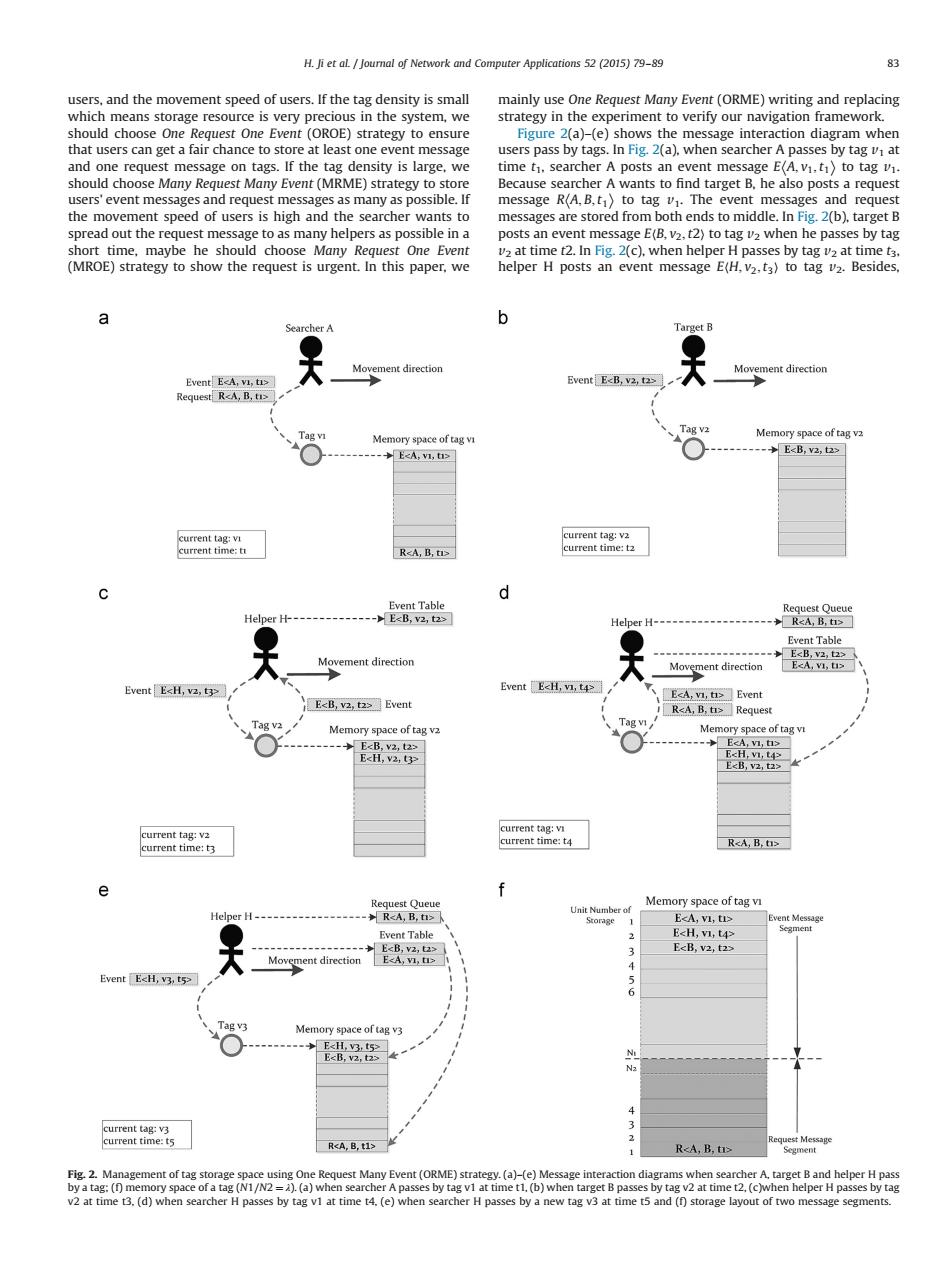正在加载图片...

H.Ji et al.Journal of Network and Computer Applications 52 (2015)79-89 83 users,and the movement speed of users.If the tag density is small mainly use One Request Many Event(ORME)writing and replacing which means storage resource is very precious in the system,we strategy in the experiment to verify our navigation framework. should choose One Request One Event(OROE)strategy to ensure Figure 2(a)-(e)shows the message interaction diagram when that users can get a fair chance to store at least one event message users pass by tags.In Fig.2(a).when searcher A passes by tag vi at and one request message on tags.If the tag density is large,we time t1.searcher A posts an event message E(A,vi,t1)to tag v. should choose Many Request Many Event(MRME)strategy to store Because searcher A wants to find target B.he also posts a request users'event messages and request messages as many as possible.If message R(A,B,t)to tag v.The event messages and request the movement speed of users is high and the searcher wants to messages are stored from both ends to middle.In Fig.2(b),target B spread out the request message to as many helpers as possible in a posts an event message E(B,v2,t2)to tag v2 when he passes by tag short time,maybe he should choose Many Request One Event vz at time t2.In Fig.2(c).when helper H passes by tag vz at time ts. (MROE)strategy to show the request is urgent.In this paper,we helper H posts an event message E(H,v2.t3)to tag v2.Besides, ⊙ b Searcher A Target B Movement direction Movement direction Event E<A,vi,ti> Event E<B,v2,ta> Request R<A,B,tis Memory space of tag vi Memory space of tag vz ---EA,V1,1> -----E<B,v2,2> current tag:vi current tag:v2 current time:tu R<A,B,ti> current time:t2 d Event Table Request Queue Helper H--- -E<B,v2,t2> Helper H- R<A,B,ti> Event Table Movement direction E<B,v2,2 Movement direction EcA,vI,t> Event E<H,v2,t3> Event E<H,vi,t4> E<A,vi,ti>Event E<B,v2,t2>Event R<A,B,ti>Request Tag v2 ag v Memory space of tag v2 Memory space of tag vi E<B,v2,t23 --E2A,n,> E<H,V2,t32 E<B,v2,t2> current tag:v2 current tag:vi current time:t4 current time:t3 R<A,B,ti> e Request●ueue Memory space of tag vi Helper H----------- Unit Number of -R<A,B,ti> Storage 1 E<A,vI,tis Event Message Event Table E<H,vi,t4> E<B,v2,t2> Movement direction EA,,t正 4 Event E<H,v3,t5> 6 Memory space of tag v3 E<H,3,t5> E<B,v2,t2> current tag:v3 3 current time:t与 R<A,B,t1> Message R<A,B,ti Segment Fig.2.Management of tag storage space using One Request Many Event(ORME)strategy.(a)-(e)Message interaction diagrams when searcher A.target B and helper H pass by a tag:(f)memory space of a tag(N1/N2=).(a)when searcher A passes by tag v1 at time t1.(b)when target B passes by tag v2 at time t2.(c)when helper H passes by tag v2 at time t3.(d)when searcher H passes by tag vI at time t4.(e)when searcher H passes by a new tag v3 at time t5 and (f)storage layout of two message segments.users, and the movement speed of users. If the tag density is small which means storage resource is very precious in the system, we should choose One Request One Event (OROE) strategy to ensure that users can get a fair chance to store at least one event message and one request message on tags. If the tag density is large, we should choose Many Request Many Event (MRME) strategy to store users' event messages and request messages as many as possible. If the movement speed of users is high and the searcher wants to spread out the request message to as many helpers as possible in a short time, maybe he should choose Many Request One Event (MROE) strategy to show the request is urgent. In this paper, we mainly use One Request Many Event (ORME) writing and replacing strategy in the experiment to verify our navigation framework. Figure 2(a)–(e) shows the message interaction diagram when users pass by tags. In Fig. 2(a), when searcher A passes by tag v1 at time t1, searcher A posts an event message E A; v1;t1 to tag v1. Because searcher A wants to find target B, he also posts a request message R A; B;t1 to tag v1. The event messages and request messages are stored from both ends to middle. In Fig. 2(b), target B posts an event message E Bh i ; v2;t2 to tag v2 when he passes by tag v2 at time t2. In Fig. 2(c), when helper H passes by tag v2 at time t3, helper H posts an event message E Hh i ; v2;t3 to tag v2. Besides, Fig. 2. Management of tag storage space using One Request Many Event (ORME) strategy. (a)–(e) Message interaction diagrams when searcher A, target B and helper H pass by a tag; (f) memory space of a tag (N1=N2 ¼ λ). (a) when searcher A passes by tag v1 at time t1, (b) when target B passes by tag v2 at time t2, (c)when helper H passes by tag v2 at time t3, (d) when searcher H passes by tag v1 at time t4, (e) when searcher H passes by a new tag v3 at time t5 and (f) storage layout of two message segments. H. Ji et al. / Journal of Network and Computer Applications 52 (2015) 79–89 83��